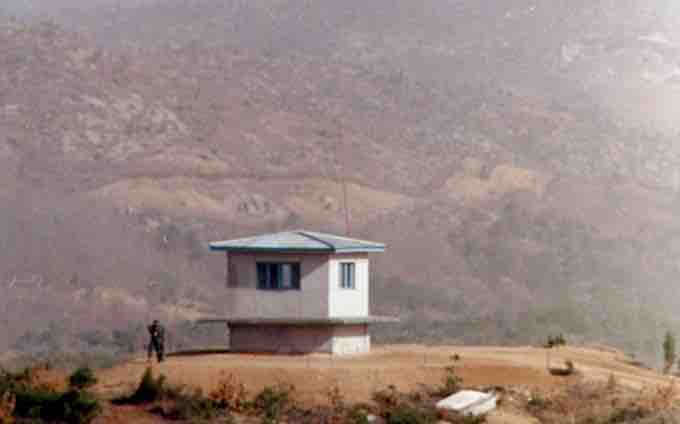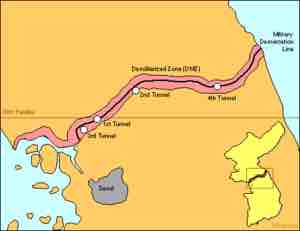The 38th Parallel
The 38th parallel north—which divides the Korean Peninsula roughly in half—was the original boundary between the United States and Soviet Union's brief administration areas of Korea at the end of World War II. Upon the creation of the Democratic People's Republic of Korea (DPRK, informally North Korea) and the Republic of Korea (ROK, informally South Korea) in 1948, it became a de facto international border and one of the most tense fronts in the Cold War.
Both the North and the South remained dependent on their sponsor states from 1948 to the outbreak of the Korean War. That conflict, which claimed over three million lives and divided the Korean Peninsula along ideological lines, commenced on 25 June 1950, with a full-front DPRK invasion across the 38th parallel, and ended in 1953 after international intervention pushed the front of the war back to near the 38th parallel.
Stalemate in Korea
After North Korean forces invaded South Korea in 1950, it only took two months for the South Korean and UN forces to be pushed back to a small area in the south. A rapid U.N. counter-offensive then drove the North Koreans past the 38th Parallel and almost to the Yalu River, when China entered the war on the side of North Korea. Chinese intervention forced the Southern-allied forces to retreat behind the 38th Parallel.
Armistice and the DMZ
The changes in territory stopped there, with both sides in their original positions near the 38th Parallel. For the rest of the war, both sides were dug in trenches and no side appeared to be winning. Almost as many bombs that had been dropped on Germany during the whole of World War II was dropped on the cities in North Korea. The need for an armistice agreement in Korea was informed by this territorial stalemate established by July 1951, as well as the heavy destruction inflicted during the war and the increasing U.S. desire to extract itself from the conflict. Peace negotiations started on July 10th 1950 and it took over three years before a ceasefire was finally reached, on 27th July 1953.
The fighting ended on 27 July 1953, when the armistice agreement was signed. The agreement restored the border between the Koreas near the 38th Parallel. It was agreed that a buffer zone, called the Korean demilitarized zone (DMZ) would be built between North and South Korea, running from the north-east of the 38th parallel to the south-west. It still stands today as the most heavily defended border in the world, defended by South Korean/US troops on one side and North Korean troops on the other. No peace treaty was signed between North and South—just a ceasefire—so technically they are still in a state of war.
Owing to this theoretical stalemate, and genuine hostility between the North and the South, large numbers of troops are still stationed along both sides of the line, each side guarding against potential aggression from the other side. The armistice agreement explains exactly how many military personnel and what kind of weapons are allowed in the DMZ. Soldiers from both sides may patrol inside the DMZ, but they may not cross the MDL; ROK soldiers, however heavily armed, patrol under the aegis of military police, and have memorized each line of the armistice. Sporadic outbreaks of violence have killed over 500 South Korean soldiers, 50 US soldiers and 250 soldiers from DPRK along the DMZ between 1953 and 1999.

North Korea DMZ
A portion of the North Korean DMZ seen from the Joint Security Area in January 1976. This border is one of the most heavily fortified in the world.

Korean Outcome
A map of the Demilitarized Zone, established by the 1953 armistice agreement that ended the Korean War.
Results of the War
The U.S. lost about 54,000 troops in the conflict and another 7,000 U.N. troops were killed. The casualty figures were even higher for the Chinese/North Koreans—an estimated 2 million to 4 million were killed or wounded. Millions more Korean civilians died.
The Korean war was the first time the Truman Doctrine, the containment of the spread of communism, was put into action. It was also the first ever time that the U.N. undertook a military operation. The war had mixed effects—it sent a clear message that the West would not tolerate any threat to its allies or sphere of influence no matter how far away they were on the map, and were prepared to defend it using force if necessary. However, engaging in the Korean War also resulted in the U.S. making even more enemies (this time with China and North Korea), and doomed already strained relations with the Soviet Union.